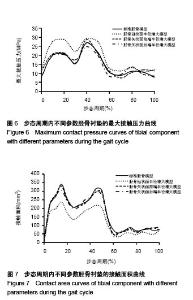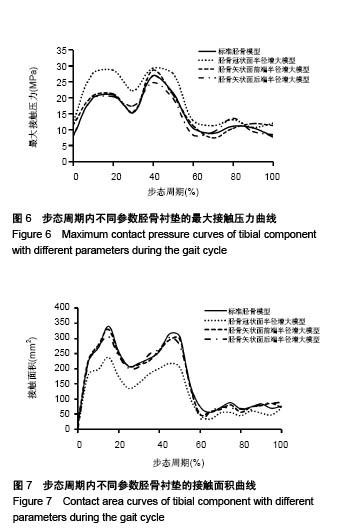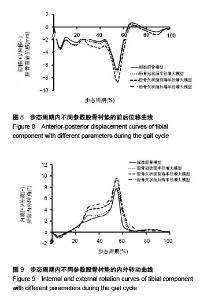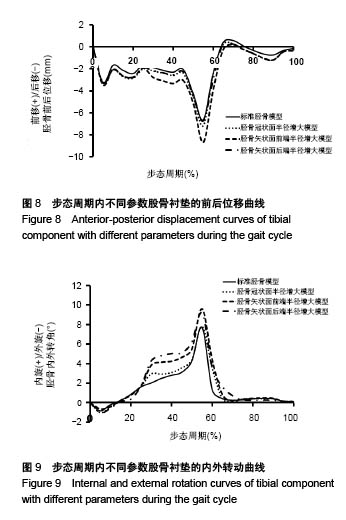| [1]Goodman SB,Gómez Barrena E,Takagi M,et al. Biocompatibility of total joint replacements: A review. J Biomed Mater Res A.2009;90(2):603-618.[2]Jun Y.Morphological analysis of the human knee joint for creating custom made implantmodels.Int J Adv Manuf Technol.2011;52(9-12):841-853.[3]Willing R,Kim IY.Multiobjective Design Optimization of Total Knee Replacements Considering UHMWPE Wear and Kinematics.12th AIAA/ISSMO Multidisciplinary Analysis and Optimization Conference Victoria, British Columbia,Canada, 2010.[4]Fitzpatrick CK,Clary CW,Laz PJ,et al.Relative contributions of design,alignment, and loading variability in knee replacement mechanics.J Orthop Res.2012;30:2015-2024.[5]Fitzpatrick CK, Clary CW, Rullkoetter PJ.The role of patient, surgical, and implant designvariation in total knee replacement performance.J Biomech 2012;45:2092-2102.[6]Willing R, Kim IY.A holistic numerical model to predict strain hardening and damage of UHMWPE under multiple total knee replacement kinematics and experimental validation.J Biomech. 2009;42(15):2520-2527.[7]Walker PS,Lowry MT,Kumar A.The effect of geometric variations in posterior-stabilized knee designs on motion characteristics measured in a knee loading machine.Clin Orthop Relat Res. 2014;472(1):238-247.[8]Willing R,Kim IY.Three dimensional shape optimization of total knee replacementsfor reduced wear. Struct Multidiscip O. 2009;38(4):405-414.[9]Fregly BJ,Marquez-Barrientos C,Banks SA,et al.Increased conformity offersdiminishing returns for reducing total knee replacement wear.J Biomech Eng.2010;132(2):021007.[10]刘艳强,龙震,黄荣瑛.渐变形面膝关节假体设计及接触应力分析[J].航天医学与医学工程,2017, 30(1):46-52.[11]Willing R,Kim IY.Quantifying the competing relationship between durability andkinematics of total knee replacements using multiobjective design optimizationand validated computational models.J Biomech.2012;45(1):141-147.[12]王建平,吴海山,王成焘.人体膝关节动态有限元模型及其在TKR中的应用[J].医用生物力学,2009,24(5):358-362.[13]Sathasivam S,Walker PS.Optimization of the bearing surface geometry of totalknees. J Biomech.1994; 27(3):255-264.[14]Willing R,Kim IY.Design optimization of a total knee replacement for improved constraint and flexion kinematics.J Biomech.2011;44(6):1014-1020.[15]Pejhan S,Bohm E,Brandt JM,et al.The influence of geometric design variables on the kinematic performance of a surface-guided total knee replacement.J Orthop Surg (Hong Kong). 2017;25(3):2309499017727922.[16]李兴.人工膝关节假体承载面几何设计及接触力学研究[D].太原:中北大学,2018.[17]李新宇.一种新型人工膝关节置换假体的设计及力学评估[D].太原:太原理工大学,2017.[18]Abdelgaied A,Liu F,Brockett C,et al.Computational wear prediction of artificial knee joints based on a new wear law and formulation.J Biomech. 2011;44(6):1108-1116.[19]Godest A,Beaugonin M,Haug E,et al.Simulation of a knee jointreplacement during a gait cycle using explicit finite element analysis.J Biomech.2002;35(2):267-275.[20]Halloran JP,Petrella AJ,Rullkoetter PJ.Explicit finite element modeling of total kneereplacement mechanics.J Biomech. 2005;38:323-331.[21]Stoltze JS.Development of a Workflow for Wear And Functional Simulation of Total Knee Replacements. Flinders University,2014.[22]Godest AC,Beaugonin M,Haug E,et al.Simulation of a knee jointreplacement during a gait cycle using explicit finite element analysis.J Biomech.2002;35(2):267.[23]van Houtem M,Clough R,Khan A,et al.Validation of the soft tissuerestraints in a force-controlled knee simulator.Proc Inst Mech Eng H.2006;220(3):449-456.[24]Walker PS, Blunn GW, Broome DR,et al.A knee simulating machine for performance evaluation of total knee replacements.J Biomech.1997;30(1):83-89.[25]Zhang J,Chen Z,Wang L,et al.Load application for the contact mechanics analysis and wear prediction of total knee replacement.Proc Inst Mech Eng H.2017;231(5):444-454.[26]Kang KT,Son J,Kim HJ,et al.Wear predictions for UHMWPE material with various surface properties used on the femoral component in total knee arthroplasty: a computational simulation study.J Mater Sci Mater Med.2017;28(7):105.[27]ISO 14243-1:2009.Implants for surgery-Wear of total knee-joint prostheses-Part1: Loading and displacement parameters for wear-testing machines withdisplacement control and corresponding environmental conditions for test. [28]Haider H,Walker PS.Analysis and recommendations for the optimum spring configurationsfor the soft tissue restraint in force-control knee simulator testing. 48thAnnual Meeting of the Orthopaedic Research Society.Dallas,TX: Orthopaedic Research Society,2002.[29]Ardestani MM,Mehran M,Jin Z.Contribution of geometric design parameters to knee implant performance: Conflicting impact of conformity on kinematics and contact mechanics. Knee.2015; 22(3):217-224.[30]McGee MA, Howie DW, Costi K, et al.Implant retrieval studies of the wear and loosening ofprosthetic joints: a review. Wear. 2000;241:158-165.[31]Swedish Knee Arthroplasty Registry:Annual Report,2011.[32]ISO 14243-3:2004.Implants for surgery-wear of total knee-joint prostheses part 3: loading and displacement parameters for wear-testing machines with displacement control and corresponding environmental conditions fortest. |



